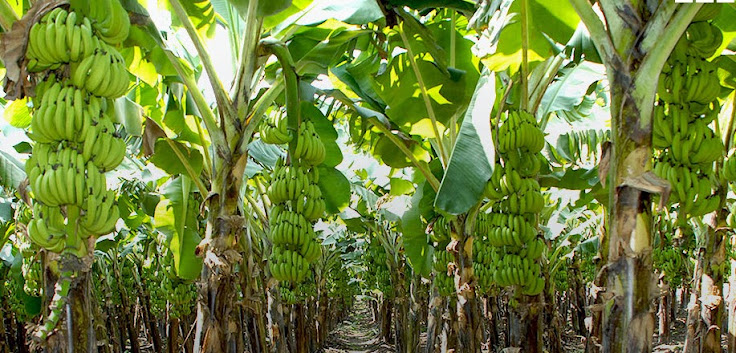A brief note about 'Banana planting and cultivation' for School children:
Presenting 'Banana plants' to invitees of marriage functions and to school children for their academic / sports achievements have become orders of the day. For one such occasion, the organizers requested me to supply a brief note about 'Banana planting and cultivation methods' along with each and every Banana plant. So, a brief note was prepared in simple words especially for school children and the same has been uploaded here in the hope that it may benefit organizers with similar cause.
Banana :
Planting and cultivation methods:
Dear Children,
What you have received now from our Chief Guest is a
Banana plant (Variety : Grande Naine) raised by Tissue culture production
technology. A brief description about how to plant it in your sweet home and
it’s cultivation methods are given hereunder.
1. The plants you have received today are very young and
must be planted the next day morning.
2. You might have noticed that the plants have young
white roots entangling the root ball which needs to be moistened always before
planting into the field. Therefore water the plants intermittently.
3. If you wish to plant them leisurely then they should
be kept in a place where there is partial shade and avoid exposure to direct
sunlight.
4. Start planting in a well prepared spot preferably in
the evening hours and irrigate it immediately.
5. Dig a circular pit
(Size 11/2 feet diameter and 1 feet depth) in
your garden preferably in the place where your kitchen waste water percolates.
Throughout the cultivation period, stagnation of water should be avoided as
this will lead to infection and subsequent rotting of plant.
6. Collect the following items at the time of
planting:(1) Neem Cake 250 gms, (2) Ground nut Cake - 500 gms, (3) Farm yard Manure – 1 basket, (4)
Vermicompost - 1 kg (5) Humic acid 10 gms and mix all the items along with the
soil dug out from the planting pit and fill the pit with the mixture.
7. The net like bag holding the root zone of the given
plant is made of biodegradable material. So there is no need to remove it and you
can plant as such in the soil.
8. Planting depth should be maximum 1cm above the top
level of bag. Deep planting should be avoided. Press the surrounding soil with
hands firmly for compaction of ground and irrigate immediately.
9. Maintain the root zone under moist condition for
10-12 days.
10. The emergence of new leaves indicates the
establishment of plants in the soil.
11. Irrigation
/ Water requirement: Young plants
need watering daily twice upto 3 months. First month: 5 litres daily twice, 2nd and 3rd
month: 10 to 15 litres daily twice, 4th to 6th months: 20 litres
daily once, 7th month: 25 litres daily and after 8th
month upto bunch harvest: 35 litres daily.
12. Weeding : Unwanted weeds that come up
surrounding the plant for up to 6 feet
radius are to be periodically removed as there will be competition for food.
13. Management
of daughter suckers : Banana plant
normally produces numerous daughter suckers all around the plant after 3 - 4
months. These daughter suckers must be removed by sawing them up to the ground
level. If you allow them to grow then the mother plant will produce smaller
size bunch only.
14. Fertilizer
application :
a.
Apply 10 kg
of Farmyard manure, 1 KG of Ground nut cake, 500 gms of Neem cake, 1Kg of
Vermi-compost, 25 gms of Humic acid in powdered form, 5 kg of rice husk ash
available in rice mills, 1 Kg of Rock phosphate, or any other organic sources
available with you in a circular fashion all around the plant. (1 feet away
on 3rd month, 2 feet away by
5th month and 21/2 feet away after 6th
month). Apply Vermi and oilcakes alone by 7th & 8th month for good bunch
development.
b. Quantity and periodicity of fertilizer application
varies depending upon the soil fertility of your garden. If the plant growth is
stunted, additional application of nutrient rich oil cakes are necessary.
15. Propping: Banana plant is not sturdier
enough to carry its own bunch. After bunch emergence you have to provide
support to the developing bunch using poles. If not, the plant will collapse
due to wind with immature fruits.
16. Harvesting : Flower emergence takes place between 6-7 months. Development
of bunch takes about 120 days. Normal size bunch is with 9 to 11 hands and are ready for
harvest by 11th or 12th month. The correct time for harvest (maturity index) is when you notice roundness of the tip of fruits and change of colour from green to light green.
17. Ripening : In India, 'Smoking method' is the age old and safe method to ripen banana. In olden days each and every house had one windowless dark room usually under the stair case or at cattle shed exclusively for ripening banana bunches. Now we have to settle with any airtight plastic or stainless steel container. Place the harvested bunch along with 3 to 4 big green banana leaves in an air tight container for 2 days. Ripening will be hastened if you place some banana peels and other unripe fruits like Mangoes, tomatoes Etc., along with banana.
Banana is the first fruit every baby gets as food after milk because its tastes great, easily digestible, and a store house of energy. A fairly inexpensive fruit when compared to the value of nutrients inside its protective skin such as: vitamins A, B1, B2, B3, B5, B6, B9, Calcium, Iron,
Magnesium, Phosphorus, Potassium and Zinc.
Think banana. Grow banana. Eat banana.
Eat for your health and to help poor farmers who tirelessly build our nations wealth.






.jpg)











 18:00
18:00
 Tissue Culture Banana Cultivation Technology
Tissue Culture Banana Cultivation Technology

 Posted in:
Posted in: 

















